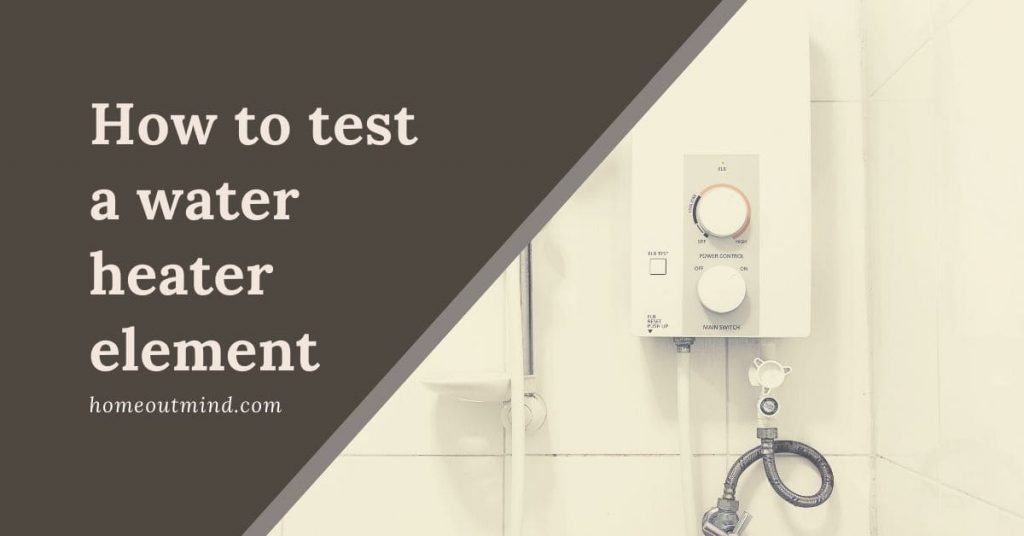Are you perplexed about how to test a water heater element? Does the process seem daunting? Fear not, as here’s a comprehensive guide to assist you.
Before delving into our topic, it’s essential to understand the components of a water heater, namely the Line Voltage & High Limit (ECO), Heating Element, Residential Thermostat, and Light Duty Commercial Thermostat.
In the following sections, we will discuss each of these elements in detail. Follow these instructions and steps carefully to learn how to effectively test a water heater element:

1) Testing for Open or Burned Out Element:
Step 1. Turn Off Power to Water Heater: Begin by switching off the power to the water heater to ensure safety.
Step 2. Access Cover Removal: Remove the access cover(s) from the front of the water heater, along with the insulation and plastic cover from the thermostat.
Step 3. Disconnect Wires: Carefully disconnect the wires from the heating element.
Step 4. Set Multimeter: Set your multimeter to the “ohms” setting.
Step 5. Touch Probes: Place the probes of the multimeter onto the screw terminals of the heating element.
Step 6. Check Reading: The reading should ideally be 12.8 ohms (±6%) for a 240-volt, 4500-watt element. You can calculate ohms using the formula: ohms = volts^2 / watts. Any reading outside this range indicates a bad element that needs replacement.
2) Testing for Heating Element Short Circuit to Ground:
Step 1. Turn Off Power to Water Heater: Ensure the power to the water heater is turned off for safety.
Step 2. Access Cover Removal: Remove the access cover(s) from the front of the water heater, along with the insulation and plastic cover from the thermostat.
Step 3. Disconnect Wires: Carefully disconnect the wires from the heating element.
Step 4. Set Multimeter: Set your multimeter to the “ohms” setting.
Step 5. Probe Placement:
- Touch one probe of the multimeter to either screw terminal of the heating element.
- Touch the other probe to the element flange. There should be no reading on the ohmmeter.
Any reading indicates a grounded element that needs replacement. Repeat this step for the other screw terminal.
How to test Line Voltage & High Limit (ECO)?
Line Voltage Testing:
- Turn Off Power: Begin by switching off the power to the water heater to ensure safety.
- Access Cover Removal: Remove the access cover(s) located at the front of the water heater. Then, take off the insulation and plastic cover from the thermostat.
- Set Multi-Meter: Set your multi-meter to measure volts AC.
- Turn Power On: Switch the power back on to the water heater.
- Check Voltage:
- If the rated voltage is present, it indicates that the power to the water heater is functioning correctly.
- If the rated voltage is not present, inspect the circuit breaker at the service panel.
High Limit (ECO) Testing:
- Check Voltage Across Terminals:
- If the rated voltage is present across the terminals, it indicates that the ECO is functioning properly.
- If the rated voltage is not present, proceed to the next step.
- Reset ECO:
- Turn off the power to the water heater and firmly press the ECO reset button on the thermostat(s).
- Turn the power back on and recheck the voltage.
- Assess ECO Status:
- If the rated voltage is present after resetting the ECO, it suggests that the ECO has opened, indicating that the water in the tank is or has been overheated. In this case, check the following:
- Ensure the thermostat is in full contact with the tank.
- Verify that the heating element(s) is not shorted to ground.
- Ensure proper thermostat operation.
- Further Action:
- If the rated voltage is still not present, and the water in the tank may be overheated:
- If the water is hot, turn off the power to the water heater and run water through the tank to cool it below the set point of the upper thermostat.
- If the water is cool, consider replacing the upper thermostat.
How to Test Your Residential Thermostat
Your residential thermostat plays a crucial role in regulating the temperature of your water heater. Ensuring it functions correctly is essential for optimal performance. Here’s a step-by-step guide to testing your residential thermostat:
1. Water In Tank Is Cold With Power On:
- Safety First: Before proceeding, turn off the power to your water heater.
- Access Cover Removal: Remove the access cover(s) from the front of the water heater and the insulation and plastic cover from the thermostat.
- Voltage Check: Set your multimeter to “Volts AC” and check for rated voltage. If absent, recheck the ECO (Emergency Cut-Off). If present, proceed to the next step.
- Further Checks: If rated voltage is absent, inspect wire connections from the thermostat to the heating element. If present, repeat element testing.
2. Water Temperature In Tank Is Above Thermostat Setting:
- Power On: Turn the power on to the water heater.
- Multimeter Setup: Set your multimeter to “Volts AC” and check for rated voltage. Replace the thermostat if present, otherwise, the thermostat is functioning correctly. Lower voltage may indicate a grounded element.
By following these steps, you can effectively test your residential thermostat and ensure your water heater operates efficiently.
How to Test a Light Duty Commercial Thermostat
Testing a light-duty commercial thermostat is crucial to ensure proper functioning of your heating system. Here’s a simple guide to help you conduct the test:
1. Power Off:
- Safety is paramount. Begin by turning off the power to your heating system.
2. Access Cover Removal:
- Remove any access covers or panels to gain access to the thermostat.
3. Disconnect Wires:
- Carefully disconnect the wires connected to the thermostat.
4. Multimeter Setup:
- Set your multimeter to the appropriate setting for voltage measurement.
5. Check Voltage:
- With the power restored to your heating system, use the multimeter to check for voltage at the terminals of the thermostat.
- If rated voltage is present, proceed to the next step. If not, check the circuit breaker and wiring connections.
6. Functional Check:
- Adjust the thermostat settings to see if it responds accordingly.
- If the thermostat controls the heating system as expected, it indicates proper functionality. If not, the thermostat may need to be replaced.
By following these steps, you can effectively test your light-duty commercial thermostat and ensure your heating system operates smoothly and efficiently.
Remember to always prioritize safety when working with electrical systems. If you’re unsure or uncomfortable with performing these tests, it’s best to consult a qualified professional.
Frequently asked questions:
How to replace a thermocouple on a water heater?
Start by ensuring the gas supply and pilot light are turned off for safety. Disconnect the old thermocouple from the control valve and carefully install the new one, making sure it’s securely connected.
Afterward, relight the pilot light following the manufacturer’s instructions. For a more detailed walkthrough, including safety precautions and troubleshooting tips, refer to our comprehensive guide on Replacing a Thermocouple on a Water Heater.
How to test a water heater element?
Begin by turning off the power to the water heater and draining the tank partially to access the heating element. Disconnect the wires from the element and use a multimeter to measure the resistance across the terminals.
Compare the resistance reading to the manufacturer’s specifications to determine if the element is functioning properly. If the reading deviates significantly, it may be necessary to replace the element. For a thorough step-by-step guide, explore our detailed post on Testing a Water Heater Element.
How to vent a tankless water heater?
Proper venting is crucial for the safe and efficient operation of a tankless water heater. Follow the manufacturer’s guidelines to determine the appropriate venting requirements for your specific model.
Select the correct type and size of vent pipe according to local building codes and regulations.
Install the vent pipe securely, ensuring proper alignment and sealing to prevent leaks and maintain optimal airflow. For a more comprehensive understanding of the venting process, check out our detailed guide on Venting a Tankless Water Heater.
Why is the water heater leaking?
Water heater leaks can be caused by various factors, such as loose fittings, corroded pipes, or a faulty pressure relief valve. Begin by inspecting the water heater for visible signs of leakage and addressing any loose connections or damaged components.
If the leak persists, it may be necessary to replace the pressure relief valve or other components. For a deeper dive into the common causes of water heater leaks and how to troubleshoot them effectively, refer to our informative guide on Water Heater Leaks.
How to strap a water heater?
Strapping a water heater is essential for seismic safety and compliance with building codes. Begin by selecting sturdy metal straps and positioning them above the midpoint of the water heater.
Securely attach the straps to the wall studs and tighten them to prevent the water heater from tipping over during seismic events. For detailed instructions and best practices on strapping a water heater, consult our comprehensive guide on Strapping a Water Heater.
How to clean a tankless water heater?
Regular maintenance, including cleaning, is vital to uphold the efficiency and longevity of your tankless water heater. The process involves flushing out mineral deposits and debris that accumulate over time, hindering performance.
Dive deep into our extensive guide on Cleaning a Tankless Water Heater to discover effective descaling methods, maintenance schedules, and expert recommendations to keep your unit running smoothly.
Conclusion
In conclusion, mastering the art of testing a water heater element is essential for maintaining the efficiency and longevity of your water heating system.
By following the step-by-step procedures outlined in this guide, you can confidently diagnose any issues, ensure proper functionality, and address potential problems promptly.
Remember, regular testing and maintenance not only optimize the performance of your water heater but also contribute to energy savings and peace of mind. So, empower yourself with the knowledge and skills needed to keep your water heater running smoothly for years to come.



